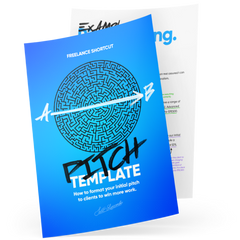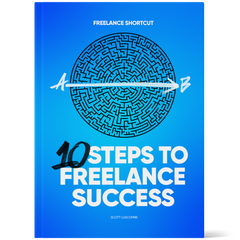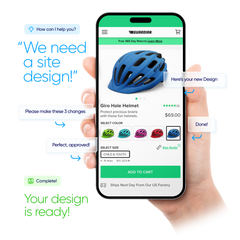Design, Development, and Marketing Services
Migrate to Shopify
Now that you've outgrown platforms such as Wix, WooCommerce, WordPress, BigCommerce, Magento, Volusion (or any other eCommerce platform), it's time to get on Shopify with expert Shopify migration. We take care of the complete migration process, which includes design, development, data migration, and search engine optimization.
How do I migrate to Shopify?
We lead the data migration process end-to-end, taking the worry out of your hands. Depending on the scale of your website, this process typically takes 2-8 weeks.
Once we have your login details and the go-ahead for migration, the next step you’ll hear is, “Your new Shopify store is done!” This service is completely done for you, and you don’t need any expertise to move your existing store to Shopify. The data migration process goes beyond just exporting your data to a CSV file for import into Shopify. With this service, I outline my process for successfully transferring your website to the Shopify platform.
Here are the eCommerce platforms we routinely migrate:
-
Wix
-
Squarespace
-
WooCommerce
-
WordPress
-
BigCommerce
-
Big Cartel
-
Shift4Shop
-
Square Online
-
Adobe Commerce
-
Magento Volusion
-
OpenCart
-
Weebly
-
PrestaShop
-
GoDaddy
-
Salesforce Commerce Cloud
The step-by-step process for moving to Shopify.
All of my packages include the below steps but are priced based on the scale of your website. The difference between packages is below.
Getting ready to migrate to Shopify
Step 1. Analyze your online Store and prepare for store migration.
The first step in your website migration to the Shopify platform is to review and map your existing pages to develop a checklist to ensure our migration efforts effectively mirror your current website. We also review the back end of your website to understand what third-party apps and plugins you may be using so we can find cross-compatible apps with the Shopify platform or install similar apps, upgrading your user experience.
What you get:
• Existing Site Analysis
• Checklist of Process
• Project Management System
• Shopify Account Setup
Moving orders and customer data
Step 2. Organize store data for the data migration process
The second step is to ensure that your existing store data seamlessly makes it through the Shopify migration process. Each platform handles customer data differently, and we ensure that your data is exported from your existing website and imported into your Shopify site without any loss. During this process, we also set a milestone to revisit customer data (which includes order data) to ensure that any information that came in during the migration process is captured.
What you get:
• Customer Data Migration
• Order Data Migration
• Content Migration
• App Data Migration
Designing your new home on Shopify
Step 3. Say goodbye to page builders and hello to Shopify
The third step is to build your website on the Shopify platform using the theme customizer. This allows you to edit the content on your website in a visual editor with no coding knowledge required. Unlike platforms like WordPress, Shopify doesn't require many plug-ins to function.
What you get:
• Design Migration
• Shopify App Setup
• Mobile Friendly Assurance
• Brand Migration
Getting you up to speed
Step 4. Teaching you how to use your new Shopify store
Rounding off turning your existing Online Store into a Shopify Store is learning how to use it. From setting up Shopify Payments, PayPal, and third-party payment gateways to learning how to keep your site up to date with front-end and back-end changes. I work with you one-on-one to ensure your success.
What you get:
• One-on-one Training (1-10 hours)
• 7 Days a Week Consultations
• Guided Learning
• Question and Answers
Which Shopify Migration Package do I need?
I offer 4 main packages for your Shopify migration project: Basic, Intermediate, Advanced, and Enterprise. Each package I offer includes the above 4 Steps with these differences:
Basic Shopify Migration Package:
The basic package is perfect for non-eCommerce sites with less than 20 pages. It includes one hour of one-on-one training to get you up to speed on editing and maintaining your website.
Intermediate Shopify Migration Package:
Select this package if you have an eCommerce website with fewer than 50 products and less than $1 million yearly sales. This package is perfect for smaller eCommerce and direct-to-consumer brands. This package includes two one-hour sessions of one-on-one training.
Advanced Shopify Migration Package:
If you have page builders and significant customization throughout your website, including numerous 3rd party apps and plug-ins, this is the package for you. We analyze which apps will work on your new Shopify Store and set up the new apps using data from your existing site. This package includes five one-hour sessions of one-on-one training.
Enterprise Shopify Migration Package:
Are you using an enterprise-level CRM such as Salesforce and an ERP to manage business resources? If so, our Enterprise migration service is for you. This package includes working directly with your IT department, Salesforce, and ERP teams to ensure a successful migration. It also includes 10 hours of one-on-one training with you and/or your entire team to get everyone up to speed.
Frequently Asked Questions
Migrating to Shopify
Can I migrate a website to Shopify?
Yes! Migrating your existing eCommerce business to a new Shopify store is possible. By moving to Shopify, you can take advantage of the easy-to-use Shopify Admin, the simple setup of Shopify Payments, and a variety of other third-party payment providers. Once your eCommerce business achieves $2 million per year, I highly recommend making the leap to Shopify Plus, which will give you a powerful set of eCommerce tools perfect for your enterprise-level business.
How do I transfer my website to Shopify?
We need to do the above steps to migrate data to your new eCommerce store. I have been selling online for over 15 years with my own eCommerce site. My current eCommerce platform is Shopify and I will be sticking with this platform for the foreseeable future. It has been a wonderful platform over the past 7 years. If you want more information about transferring your existing website to Shopify, please call me at 315-791-7511.
How do I migrate to Shopify without losing my SEO?
Shopify stores have extremely easy-to-use SEO tools built right into the Shopify admin. By connecting Google Analytics and Google Search Console, you can easily monitor the health of your search engine optimization strategies and traffic. Shopify stores and Shopify apps use different URL structures. Every other migration service will say, "You will see zero drop in your organic traffic using our migration." But it's misleading. Whenever there is a change in page structure, there is a change in traffic, and only Google controls that. During the most recent migrations, I have seen a dip of about 25% in organic traffic for 2 weeks to a month, then it comes back even better. The problem is thousands of variables, from how old your domain name is to how often your site is updated, and thousands more considerations that make up the Google algorithm. Beware of service providers who say there will be no drop; they absolutely can not control Google; if they could, they'd be billionaires and not migrating your website.
Here's how to save your SEO ranking during Shopify Migration.
This is because search engines have established a relationship with your current site: they've crawled its pages, indexed its content, and understood its relevance to specific topics and audiences. Google's crawlers likely visit your site regularly to look for updates and are familiar with its structure.
However, when you migrate to a new platform, you present search engines with a different website, potentially disrupting this established relationship. Consider all the changes that come with a migration:
-
New URLs: Shopify employs a standard URL structure, necessitating changes to your existing URLs.
-
Internal Linking Structure: Your internal linking structure will also need adjustment with URL changes. Additionally, the new website may introduce a different information architecture.
-
HTML: The new site will likely have different HTML, which needs to be processed by Google's indexing system.
-
Server: Shopify websites are hosted on Shopify's servers, meaning a migration results in serving your site from a new server.
-
Content: During a website rebuild, it's common to make changes to content.
These changes can be substantial, requiring search engines to process and recalculate your website's ranking and visibility.
Proper SEO planning during migration allows Google to process these changes, leading to clarity and potentially declining organic visibility. Organic traffic is vital for many websites, and a significant drop in rankings can severely impact the business.
Therefore, integrating SEO planning into your Shopify migration is crucial to mitigate the risk of disruptions to your rankings and maintain organic traffic, which is often a business's primary acquisition channel.
Migration Tools
In this guide, we'll rely on several tools to facilitate the migration process:
-
Crawling Software: Access to crawling software is essential. While we prefer Screaming Frog, alternatives such as Sitebulb and Deepcrawl are also effective.
-
Google Analytics and Search Console: Full access to Google Analytics and Search Console for the site you're migrating is crucial for comprehensive insights into site performance and search data.
-
Lucid Chart, Miro, and Google Sheets: Mapping out your website is critical to SEO success. In fact, I can often significantly improve your website traffic during migration by driving traffic to the correct pages.
-
Ahrefs/SEMRush: Supplemental SEO tools like Ahrefs and SEMRush provide valuable additional keyword and link data, enhancing migration.





